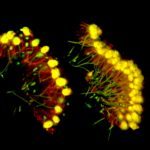Lien vers Pubmed [PMID] – 35472432
Lien DOI – 10.1016/j.cub.2022.03.021
Curr Biol 2022 Apr; 32(8): R385-R397
The textbook view of cell division terminates with the final separation of the two daughter cells in the process called abscission. However, in contrast to this classical view, a variety of cell types in multicellular organisms are connected through cytoplasmic bridges, which most often form by incomplete abscission or – more rarely – by local fusion of plasma membranes. In this review, we survey the distribution, function, and formation of cytoplasmic bridges across the eukaryotic tree of life. We find that cytoplasmic bridges are widespread, and were likely ancestrally present, in almost all lineages of eukaryotes with clonal multicellularity – including the five ‘complex multicellular’ lineages: animals, fungi, land plants, red algae, and brown algae. In animals, cytoplasmic bridges resulting from incomplete abscission are ubiquitous in the germline and common in pluripotent cell types. Although cytoplasmic bridges have been less studied than other structural mediators of multicellularity (such as adhesion proteins and extracellular matrix), we propose that they have played a pivotal role in the repeated evolution of eukaryotic clonal multicellularity – possibly by first performing a structural role and later by allowing exchange of nutrients and/or intercellular communication, which notably buffered cell-cell competition by averaging gene expression. Bridges were eventually lost from many animal tissues in concert with the evolution of spatial cell differentiation, cell motility within the organism, and other mechanisms for intercellular distribution of signals and metabolites. Finally, we discuss the molecular basis for the evolution of incomplete abscission and examine the alternative hypotheses of single or multiple origins.

